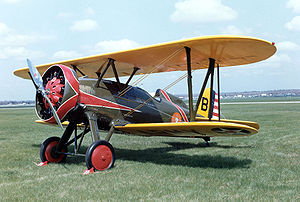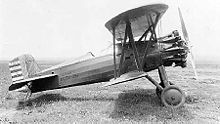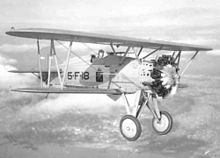- Boeing P-12
-
P-12 / F4B Boeing P-12E at the National Museum of the United States Air Force, in markings of 6th Pursuit Squadron, 18th PG, Wheeler Field, Hawaii Role Fighter aircraft Manufacturer Boeing Aircraft Company First flight June 25, 1928 Introduction 1930 Retired 1949 Brazilian Air Force [1] Primary users United States Army Air Corps
United States Navy
Philippine Army Air Corps
Royal Thai Air ForceProduced 1929-1932 Number built 586[2]
*366 P-12
*187 F4B
*33 demonstrators and exportsThe Boeing P-12 or F4B was an American pursuit aircraft that was operated by the United States Army Air Corps and United States Navy.
Contents
Design and development
Boeing developed the aircraft as a private venture to replace the Boeing F3B and Boeing F2B with the United States Navy that was the first flight of the P-12 took place on June 25, 1928. The new aircraft was smaller, lighter and more agile than the ones it replaced but still used the Wasp engine of the F3B. This resulted in a higher top speed and overall better performance. As result of Navy evaluation 27 were ordered as the F4B-1, later evaluation by the United States Army Air Corps resulted in orders with the designation P-12. Boeing supplied the USAAC with 366 P-12's between 1929 and 1932. Production of all variants totalled 586.
Operational history
P-12s were flown by the 17th Pursuit Group (34th, 73rd, and 95th Pursuit Squadrons) at March Field, California, and the 20th Pursuit Group (55th, 77th and 79th Pursuit Squadrons) at Barksdale Field, Louisiana. Older P-12s were used by groups overseas: the 4th Composite Group (3rd Pursuit Squadron) in the Philippines, the 16th Pursuit Group (24th, 29th, 74th, and 79th Pursuit Squadrons) in the Canal Zone, and the 18th Pursuit Group (6th and 19th Pursuit Squadrons) in Hawaii.
The P-12 remained in service with first-line pursuit groups until replaced by Boeing P-26s in 1934–1935. Survivors were relegated to training duties until 1941, when most were grounded and assigned to mechanics's schools.
Civil and commercial models
Commencing in 1929 Boeing produced four commercial and export variants of the Model 100 with an affinity to both the Army P-12 and Navy F4B-1. The principal differences were the deletion of standard U.S. military equipment and the installation of the fuel tank in the center-section of the upper wing.
Model 100
The first Model 100, the commercial counterpart of the F4B-1/P-12 Model 100 flew on October 8th 1929 and was sold to the Bureau of Air Commerce (now the FAA) with the Government aircraft registration NS-21.
The second, NX872H, was sold to Pratt & Whitney for use as an engine test bed; apart from the original R-1340 "Wasp", this airplane also flew the R-98S "Wasp Junior", the R-1535 "Twin Wasp Junior" and the R-1690 "Hornet" engines. It was then sold to stunt pilot Milo Burcham who used it for display flying between 1933 and 1941 as NC-872H with distinctive modifications. The space between the undercarriage legs was faired-in, low-pressure tires fitted, and metal paneling replacing the fuselage fabric. At the time of writing (1964) the airplane is currently owned by Paul Mantz of Santa Ana, California.
The third Model 100 has had the most varied career and has carried every possible combination of U.S. civil registration, commencing with the plain 873H and passing through C, AT, NR, NX to N873H. It was used at the factory for several years as a test machine and demonstrator, and was then sent to the Boeing School of Aeronautics at Oakland, California, for use as an advanced trainer. It was acquired about 1936 by Paul Mantz for display and movie flying and is still being used for such. It is now powered by a war-surplus Wasp Junior driving a controllable-pitch propeller.
Last of the Model 100s, NX874H, was also used as a company demonstrator and was eventually sold to the Mitsui Company of Japan.
Model 100A
The Model 100A was a special convertible two-seat version of the basic Model 100 built to the special order of Mr. Howard Hughes. Hughes undertook many extensive modifications before the aircraft was sold to Col. Arthur Goebel as a single seater. Registered 247K it was destroyed in 1957.
Model 100E
Two Model 100Es were built for Siam (now Thailand) and were export versions of the P-12E. Owing to a ruling that export of aircraft currently in production for U.S. Forces could not be undertaken, the Boeing Model 234 designation was changed to 100E though general structure and performance was similar to that of the P-12E. Both 100Es were delivered in a dismantled state on November 10th 1931. The last surviving example (taken over by the Japanese during World War II), is currently preserved in the Thai Aeronautical Museum at Bangkok.
Model 100F
The Model 100F was a one-off commercial equivalent of the P-12F delivered to Pratt & Whitney for engine testing. First engine fitted was the 700hp R-1535 Twin Wasp Junior and with this was flown on June 20th 1932. So great was the diameter of the propeller used that both take-off and landing had to be performed in the "three-point" attitude to maintain ground clearance.
The 100F also flew with the Hornet and Wasp engines. On one occasion it flew with each of the engines during the course of a single day as a demonstration of quick engine-changing techniques. Because of the different engine weights, the balance of the airplane was corrected during these engine changes by use of a sliding weight in the fuselage between the cockpit and tail. On a test flight the pilot lost consciousness due to a failure in the oxygen supply and the 100F fell into a spin. Not being designed to withstand the loads imposed by these gyrations, the weight broke loose and destroyed the flying controls - preventing recovery from the spin.
Variants
- Model 83
- One prototype with spreader bar landing gear and 425hp Pratt & Whitney R-1340-8 engine, later designated XF4B-1 for Navy evaluation.
- Model 89
- One prototype with split-axle undercarriage and provision for a 500 lb bomb on ventral rack, later designated XF4B-1 for Navy evaluation.
- P-12
- Model 102, Army version of the F4B-1 with a 450 hp R-1340-7 engine, nine built.
- XP-12A
- 10th built P-12 with NACA cowl a 525hp R-1340-9 engine and shorter undercarriage, one built.
- P-12B
- Model 102B, as P-12 with larger mainwheels and improvements tested on XP-12A, 90 built.
- P-12C
- Model 222, as P-12B with ring cowl and spread-bar undercarriage, 96 built.
- P-12D
- Model 234, as P-12C with a 525 hp R-1340-17 engine, 35 built.
- P-12E
- Model 234, as P-12D with semi-monocoque metal fuselage, redesigned vertical tail surfaces, some were later fitted with tailwheels instead of skids, 110 built.
- P-12F
- Model 251, as P-12E with a 600 hp R-1340-19 engine, 25 built.
- XP-12G
- P-12B modified with a R-1340-15 engine with side-type supercharger, one converted.
- XP-12H
- P-12D modified with a GISR-1340E experimental engine, one converted.
- P-12J
- P-12E modified with a 575 hp R-1340-23 engine, and special bomb sight, one conversion.
- YP-12K
- P-12E and P-12J re-engined with a fuel injected SR-1340E engine, seven temporary conversions.
- XP-12L
- YP-12K temporary fitted with a F-2 supercharger, one converted.
- A-5
- designation for proposed use of P-12 as a radio-controlled target drone (cancelled)
- XF4B-1
- Designation given to two prototypes for Navy evaluation, the former Model 83 and the former Model 89.[3]
- F4B-1
- Boeing Model 99 for the United States Navy, split axle landing gear and ventral bomb rack, 27 built.[4]
- F4B-1A
- One F4B-1 converted to unarmed executive transport for the Assistant Secretary of the Navy, fuel tank moved to upper wing centre section.[5]
- F4B-2
- Boeing Model 223, spreader bar landing gear, frise ailerons, tailwheel replacing skid, 46 built.[6]
- F4B-3
- Boeing Model 235, as F4B-2 but with semi-monocoque metal fuselage and equipment changes, 21 built.[7]
- F4B-4
- Boeing Model 235, as F4B-3 but with redesigned vertical tail surfaces, 550 hp R-1340-16 engine, underwing racks for two 116 lb bombs, last 45 built had an enlarged headrest housing a life raft, 92 built and one built from spares.[8]
- F4B-4A
- 23 assorted P-12 aircraft transferred from USAAC for use as a radio-controlled target aircraft.[9]
- Model 100
- Civil version of the F4B-1, four built.[10]
- Model 100A
- Two-seat civil version for Howard Hughes, later converted to a single-seater, one built.[11]
- Model 100D
- One Model 100 temporary used as a P-12 demonstrator.[12]
- Model 100E
- Export version of the P-12E for the Siamese Air Force, two built, one later transferred to the Japanese Navy under the designation AXB.[13]
- Model 100F
- One civil variant of the P-12F sold to Pratt & Whitney as an engine test bed.[14]
- Model 218
- Prototype of the P-12E/F4B-3 variant, after evaluation sold to the Chinese Air Force.[15]
- Model 256
- Export version of the F4B-4 for Brazilian Navy, 14 built.[16]
- Model 267
- Export version for Brazil with an F4B-3 fuselage and P-12E wings, 9 built.[17]
Operators
 Brazil
Brazil China
China
- Chinese Nationalist Air Force
- Royal Thai Air Force operated Boeing 100E variant.
Aircraft on display
- A surviving P-12E is on display at the National Museum of the United States Air Force at Wright-Patterson AFB near Dayton, Ohio.
- One of the four Model 100s is displayed at Museum of Flight, Seattle, Washington, United States
- A replica P-12B is on display at the Tennessee Museum of Aviation in Sevierville, Tennessee
- An F4B-4 "Felix the cat" is displayed in the entrance hall of the Honolulu International Airport
- A P-12F converted to specifications of an F4B-4 and painted with the markings of Fighting Squadron 6B "Felix the Cat" is on display at the National Museum of Naval Aviation in Pensacola, FL
- A Model 100E on display at Royal Thai Air Force Museum, Don Muang Royal Thai Air Force Base.
Specifications (P-12E)
Data from Bowers, 1989. pg.
General characteristics
- Crew: 1
- Length: 20 ft 4 in (6.19 m)
- Wingspan: 30 ft (9.14 m)
- Height: 9 ft (2.74 m)
- Loaded weight: 2,690 lb (1,220 kg)
- Powerplant: 1 × Pratt & Whitney R-1340-17 Radial engine, 500 hp (373 kW)
Performance
- Maximum speed: 189 mph (304 km/h)
- Cruise speed: 160 mph (257 km/h)
- Range: 570 miles (917 km)
Armament
- Guns: Two .30 inch (7.62 mm) machine guns or one .30 inch (7.62 mm) and one .50 inch (12.7 mm) machine guns
- Bombs: 244 lb (111 kg) of bombs carried externally.
See also
- Related lists
- List of military aircraft of the United States
- List of fighter aircraft
References
- Notes
- ^ "Historical Listings: Brazil, (BRZ)."] World Air Forces. Retrieved: 19 May 2011.
- ^ "F4B." VF31.com. Retrieved: 10 June 2011.
- ^ Bowers 1989, p. 166.
- ^ Bowers 1989, p. 168.
- ^ Bowers 1989, p. 170.
- ^ Bowers 1989, p. 181.
- ^ Bowers 1989, pp. 187–188
- ^ Bowers 1989, pp. 188–189.
- ^ Bowers 1989, pp. 189–190.
- ^ Bowers 1989, pp. 171–172.
- ^ Bowers 1989, pp. 173–174.
- ^ Bowers 1989, p. 175.
- ^ Bowers 1989, p. 175–176.
- ^ Bowers 1989, p. 176.
- ^ Bowers, 1989. pp. 179–180.
- ^ Bowers 1989, pp. 192–193.
- ^ Bowers 1989, p. 193
- Bibliography
- Baugher, Joe. "Boeing P-12." American Military Aircraft, 6 June 1998. Retrieved: 10 June 2011.</ref>
- Bowers, Peter M. Boeing aircraft since 1916. London: Putnam Aeronautical Books, 1989. ISBN 0-85177-804-6.
External links
- P-12 fact sheet at the National Museum of the United States Air Force
- Joe Baugher's P-12 History Page
- The Boeing P-12/F4b picture page
- Boeing F4B US Navy Version
Boeing model numbers Aircraft 1 · 2 · 3 · 4 · 5 · 6 · 6D · 6E · 7 · 8 · 10 · 15 · 16 · 21 · 40 · 42 · 50 · 53 · 54 · 55 · 58 · 63 · 64 · 66 · 67 · 68 · 69 · 72 · 74 · 75 · 77 · 80 · 81 · 83 · 89 · 93 · 95 · 96 · 99 · 100 · 101 · 102
200 · 202 · 203 · 204 · 205 · 214 · 215 · 218 · 221 · 222 · 223 · 226 · 227 · 234 · 235 · 236 · 246 · 247 · 248 · 251 · 256 · 264 · 266 · 267 · 273 · 281 · 294 · 299 · 300 · 306 · 307 · 314 · 316 · 344 · 345 · 367 · 367-80 · 377 · 400 · 450 · 451 · 464 · 474 · 701
707 · 717 (i) · 717 (ii) · 720 · 727 · 733 · 737 · 747 · 757 · 767 · 777 · 787 · 2707
Turbine engines 502 · 520 · 550
Vessels 929
USAAS/USAAC/USAAF/USAF fighter designations 1924–1962 Pursuit (pre-1948)
Fighter (post-1948)P-1 • P-2 • P-3 • XP-4 • P-5 • P-6 • XP-7 • XP-8 • XP-9 • XP-10 • P-11 • P-12 • XP-13 • XP-14 • XP-15 • P-16 • XP-17 • XP-18 • XP-19 • YP-20 • XP-21 • XP-22 • XP-23 • YP-24 • Y1P-25 • P-26 • YP-27 • Y1P-28 • P-29 • P-30 • XP-31 • XP-32 • XP-33 • XP-34 • P-35 • P-36 • XP-37 • P-38 • P-39 • P-40 • XP-41 • XP-42 • P-43 • P-44 • XP-45 • XP-46 • P-47 • XP-48 • XP-49 • XP-50 • P-51 • XP-52 • XP-53 • XP-54 • XP-55 • XP-56 • XP-57 • XP-58 • P-59 • YP-60 • P-61/RF-61C • XP-62 • P-63 • P-64 • XP-65 • P-66 • XP-67 • XP-68 • XP-69 • P-70 • XP-71 • XP-72 • XP-73 • (P-74 not assigned) • P-75 • XP-76 • XP-77 • XP-78 • XP-79 • P-80 • XP-81 • P-82 • XP-83 • P-84 • XP-85 • P-86/F-86D • XP-87 • XP-88 • P-89 • XF-90 • XF-91 • XF-92 • YF-93 • F-94 • YF-95 • YF-96 • F-97 • XF-98 • F-99 • F-100 • F-101 • F-102 • XF-103 • F-104 • F-105 • F-106 • F-107 • XF-108 • XF-109 • F-110 • F-111/F-111B
Pursuit, Biplace Fighter, Multiplace YFM-1 • XFM-2
USAAF drone aircraft Controllable bombs Target control aircraft Aerial target (subscale) Aerial target (full-scale) USN fighter designations pre-1962 General Aviation
BrewsterBoeing Curtiss Douglas
McDonnellGrumman Eberhart
GoodyearHall
McDonnellBerliner-Joyce
North American AviationLoening
BellGeneral Motors Seversky FN
Lockheed Ryan FR • XF2R
Northrop Vought Lockheed Wright Convair Japanese Navy Carrier Fighters designation series Lists relating to aviation General Aircraft (manufacturers) · Aircraft engines (manufacturers) · Airlines (defunct) · Airports · Civil authorities · Museums · Registration prefixes · Rotorcraft (manufacturers) · TimelineMilitary Accidents/incidents Records Categories:- Single-engine aircraft
- United States fighter aircraft 1920–1929
- Boeing aircraft
Wikimedia Foundation. 2010.




